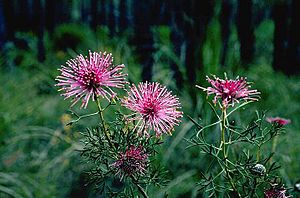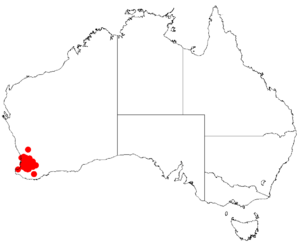Isopogon crithmifolius facts for kids
Quick facts for kids Isopogon crithmifolius |
|
|---|---|
 |
|
| Scientific classification | |
| Genus: |
Isopogon
|
| Species: |
crithmifolius
|
 |
|
| Occurrence data from Australasian Virtual Herbarium | |
| Synonyms | |
|
Atylus crithmifolius (F.Muell.) Kuntze |
|
The Isopogon crithmifolius is a special type of plant. It belongs to the Proteaceae family, which includes many unique Australian plants. This shrub is found only in the south-west part of Western Australia. This means it is endemic to that area.
It is known for its interesting leaves and its pretty reddish-pink flowers. These flowers grow in round clusters.
About the Plant
The Isopogon crithmifolius is a shrub that usually grows to be about 0.4 to 1.3 meters (about 1.3 to 4.3 feet) tall. It has light brown branches that feel a bit hairy.
Its leaves are quite long, from 150 to 400 millimeters (about 6 to 16 inches). They grow on a short stem called a petiole, which is about 12 to 25 millimeters long. The leaves are often split into two or three main parts, and these parts can be split again.
Flowers and Fruit
The flowers of this plant are a beautiful reddish-pink color. They are glabrous, which means they are smooth and do not have any hairs. These flowers grow together in round, tight clusters. Each cluster is about 30 to 35 millimeters (about 1.2 to 1.4 inches) wide.
At the bottom of each flower cluster are special leaf-like parts called involucral bracts. These bracts are shaped like an egg. Each individual flower is about 25 to 30 millimeters long.
The Isopogon crithmifolius usually blooms from September to October. After the flowers, the plant produces a type of fruit called a nut. These nuts are oval-shaped and hairy. They grow together, forming a round cone about 15 to 20 millimeters (about 0.6 to 0.8 inches) wide.
Plant Discovery
The Isopogon crithmifolius was first officially described in 1868. A famous botanist named Ferdinand von Mueller gave it its scientific name. He wrote about it in a book called Fragmenta phytographiae Australiae. The plants he studied were collected by another botanist, James Drummond.
Where it Grows
This special isopogon shrub grows in forests and woodlands. You can find it in the south-west of Western Australia. Its habitat stretches from near the city of Perth all the way to a town called Cranbrook. It lives in specific natural areas known as the Avon Wheatbelt, Jarrah Forest, and Swan Coastal Plain.
Conservation Status
Good news! The Government of Western Australia's Department of Parks and Wildlife has classified Isopogon crithmifolius as "not threatened". This means it is not currently in danger of disappearing.

